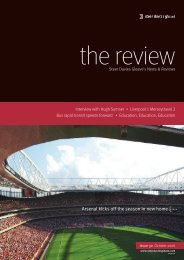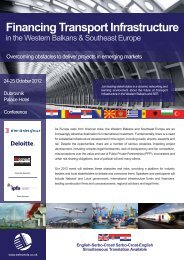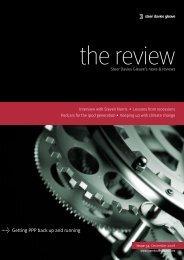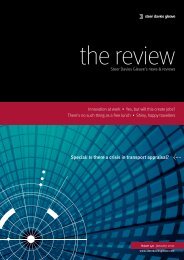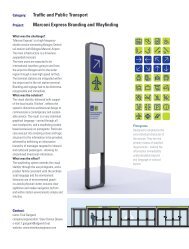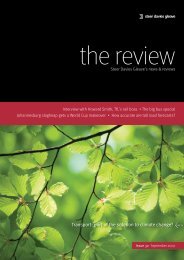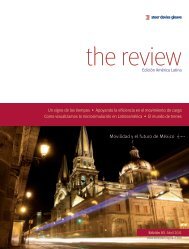California's need for speed - Steer Davies Gleave
California's need for speed - Steer Davies Gleave
California's need for speed - Steer Davies Gleave
Create successful ePaper yourself
Turn your PDF publications into a flip-book with our unique Google optimized e-Paper software.
News in brief<br />
Rail market share (%)<br />
Rail<br />
market<br />
share (%)<br />
This high capacity enables the operator to<br />
offer a number of different product offers<br />
on the same train and be competitive<br />
with other modes, typically air and<br />
conventional train in Europe. The proposed<br />
Cali<strong>for</strong>nian operation compares well with<br />
this approach with 128 trains a day in each<br />
direction being proposed <strong>for</strong> the corridor;<br />
operating up to 1,100 seats a train.<br />
Competition – as mentioned, air and<br />
conventional rail are the main competitors<br />
to high <strong>speed</strong> rail; with conventional rail<br />
virtually non existent in Cali<strong>for</strong>nia, it will<br />
be interesting to see how the new<br />
services impact on a very entrenched<br />
and professional air market. The table<br />
below shows the increases in market<br />
share achieved by a number of high<br />
<strong>speed</strong> introductions. Traditionally high<br />
<strong>speed</strong> introductions have seen little transfer<br />
from the car market. This might be different<br />
in Cali<strong>for</strong>nia, especially with the introduction<br />
of strong environmental legislation of the<br />
same period.<br />
100%<br />
90%<br />
80%<br />
70%<br />
60%<br />
50%<br />
40%<br />
30%<br />
20%<br />
10%<br />
0%<br />
Frankfurt-Cologne<br />
London - Manchester<br />
London - Brussels<br />
Madrid - Seville<br />
London - Paris<br />
Paris - Maeseille<br />
Madrid - Barcelona<br />
00:00 01:00 02:00 03:00 04:00 05:00 06:00 07:00 08:00<br />
Rail journey time<br />
Rome- Milan<br />
Cost – costs of high <strong>speed</strong> rail (186+mph)<br />
100%<br />
has come down Frankf urt-Cologne in recent years, with both<br />
90%<br />
Spain and France Madrid-Seville achieving a construction<br />
80%<br />
London-Manchest er London-Paris<br />
cost 70% of under $10million per mile <strong>for</strong> their<br />
Pari s-Marsei lle<br />
60%<br />
London-Brus sels<br />
latest schemes.<br />
However, tunnels and viaducts probably<br />
increase the cost by a factor of up to five<br />
and steep gradients also increases cost,<br />
as does movement though urban areas. In<br />
fact, some recent schemes have chosen to<br />
run underground rather than disturb major<br />
urban areas, an example of this would be<br />
the High Speed 2 link into London.<br />
Risks – because risks vary with the<br />
different stages in the development of a<br />
high <strong>speed</strong> scheme, it is essential that<br />
the various risks are assigned to the<br />
party (public or private) that is in the best<br />
position to handle that risk. Construction<br />
risk all but disappears once the line is<br />
operational (except <strong>for</strong> residual defects);<br />
demand and revenue risk reduces over<br />
time as a history is built up of actual<br />
service; while operation risk continues the<br />
length of the concession and might even<br />
be the subject of sharp peaks, <strong>for</strong> example<br />
if a new generation of trains is introduced.<br />
Cali<strong>for</strong>nia will be holding a referendum in<br />
November this year as to whether it should<br />
proceed with the development of its high<br />
<strong>speed</strong> network at this time. If successful,<br />
<strong>Steer</strong> <strong>Davies</strong> <strong>Gleave</strong> will be looking <strong>for</strong>ward<br />
to playing an active role in its development<br />
over the next decade.<br />
An expert in railways, Richard leads SDG’s<br />
rail projects outside the UK, in particular<br />
supporting operators, investors and<br />
government sponsors in the restructuring<br />
and commercial development of the<br />
industry and in developing, bidding and<br />
awarding rail concessions and franchises.<br />
To find out more or discuss further contact<br />
richard.middleton@sdgworld.net<br />
Peering into Ottawa’s future<br />
<strong>Steer</strong> <strong>Davies</strong> <strong>Gleave</strong> is taking part in a peer<br />
review panel to look at Ottawa’s long-term<br />
transit investment plans that will help shape<br />
the city’s future. While the peer review<br />
initially examined proposals to upgrade<br />
the city’s current busway system, the panel<br />
has posed a series of key challenges <strong>for</strong> the<br />
city that go beyond a ‘transit only’ review.<br />
Looking out to 2031, the panel wanted<br />
a clearer view of what role Ottawa would<br />
have as a 21st century capital city and has<br />
recommended a concentration on higher<br />
density, more sustainable land use within the<br />
existing Green Belt, supported by the busway<br />
being upgraded to light rail, including an<br />
extension to serve the international airport. A<br />
fully integrated network would also see major<br />
investment in bus and streetcar systems.<br />
All go in Atlanta<br />
Host of the 1996 Olympics and the world<br />
headquarters of Coca Cola, Atlanta is<br />
developing a long-term transportation<br />
plan as part of its aim to be one of North<br />
America’s premier cities. <strong>Steer</strong> <strong>Davies</strong> <strong>Gleave</strong><br />
is bringing our European/World experience<br />
and expertise in evaluation methodologies<br />
to the project. Our input has covered the<br />
latest innovations in transit and an emphasis<br />
on integrated solutions incorporating<br />
transit investment, transportation demand<br />
management and stronger links to<br />
sustainable land use policies. We will also<br />
be advising on comprehensive, multi-modal<br />
strategy evaluation techniques as the<br />
strategy work develops.<br />
The carbon calculator<br />
It is clear that minimizing CO 2<br />
emissions<br />
and impacts on climate change is becoming<br />
a bigger priority <strong>for</strong> organizations around<br />
the world. <strong>Steer</strong> <strong>Davies</strong> <strong>Gleave</strong> recently<br />
developed a ‘carbon calculator’ <strong>for</strong> the<br />
European Bank <strong>for</strong> Reconstruction and<br />
Development to determine CO 2<br />
emissions<br />
from potential local transportation projects.<br />
The calculator was developed by classifying<br />
potential transportation investments,<br />
including bus fleets and tram/light-rail<br />
systems. They were assessed based on<br />
the degree to which the investment would<br />
encourage individuals to use their cars less,<br />
in favor of more sustainable modes of travel.<br />
3




